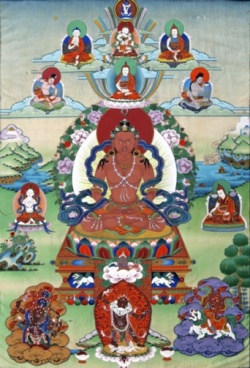Shijie (屍解) is a practise whereby taoists vanished into the sky.
Human beings have three main possibilities for rebirth. One of them is based on a new view of *shijie (release from the corpse) as a stage of Taoist ascesis: when purification during life has remained incomplete, the body awaits purification in an intermediary realm such as the Great Yin (Taiyin). The adept may also be reborn in paradises where he undergoes purification by fire and is revived as an immortal. Finally, rebirth can also occur during one's lifetime, through experiencing again one's embryonic development. The latter method is called "nine transmutations" (jiuzhuan) or "ninefold elixir" (jiudan), two terms that relate rebirth to alchemy but on a purely spiritual level.
Jhalu or The Rainbow Body A teacher or yogi who has acquired the highest forms of accomplishment can manifest what is called "the rainbow body" or "body of light." Usually this happens after death, but it has been known to happen at other times. For example, one of the 8 forms of Guru Rinpoche (Padmasambhava) is The Rainbow. HH the 16th Karmapa was observed by many people as he temporarily dissolved in this way during a Black Crown ritual.
Those who have mastered the trek-chod phase of Dzogchen in which pure and total presence is stabilized, are able to do to-gal. This is the final Dzogchen practice which enables the yogi at the time of death to dissolve his or her physical body into the essence of the elements. The yogin then disappears into a " body of light" leaving behind only the hair, toe and finger nails, and the nasal septum.
Sogyal Rinpoche wrote, "
In 1952 there was a famous instance of the rainbow body in the East of Tibet, witnessed by many people. The man who attained it, Sonam Namgyal, was the father of my tutor at the beginning of this book.
He was a very simple, humble person, who made his way as an itinerant stone carver, carving mantras and sacred texts. Some say he had been a hunter in his youth, and had received a teaching from a great master. No one really knew he was a practitioner; he was truly called a "hidden yogin."
. . . he then fell ill, or seemed to, but became strangely, increasingly happy. When he illness got worse, his family called in masters and doctors. His son told him he should remember, 'Everything is illusion, but I am confident that all is well.'
Just before his death at seventy-nine, he said "All I ask is that when I die, don't move my body for a week." When he died his family wrapped his body and invited Lamas and monks to come and practice for him. They placed the body in a small room in the house, and they could not help noticing that although he had been a tall person, they had no trouble getting it in, as if he were becoming smaller. At the same time, an extraordinary display of rainbow-coloured light was seen all around the house. When they looked into the room on the sixth day, they saw that the body was getting smaller and smaller. On the eight day after his death, the morning in which the funeral had been arranged, the undertakers arrived to collect the body. When they undid its coverings, they found nothing inside but his nails and hair.
